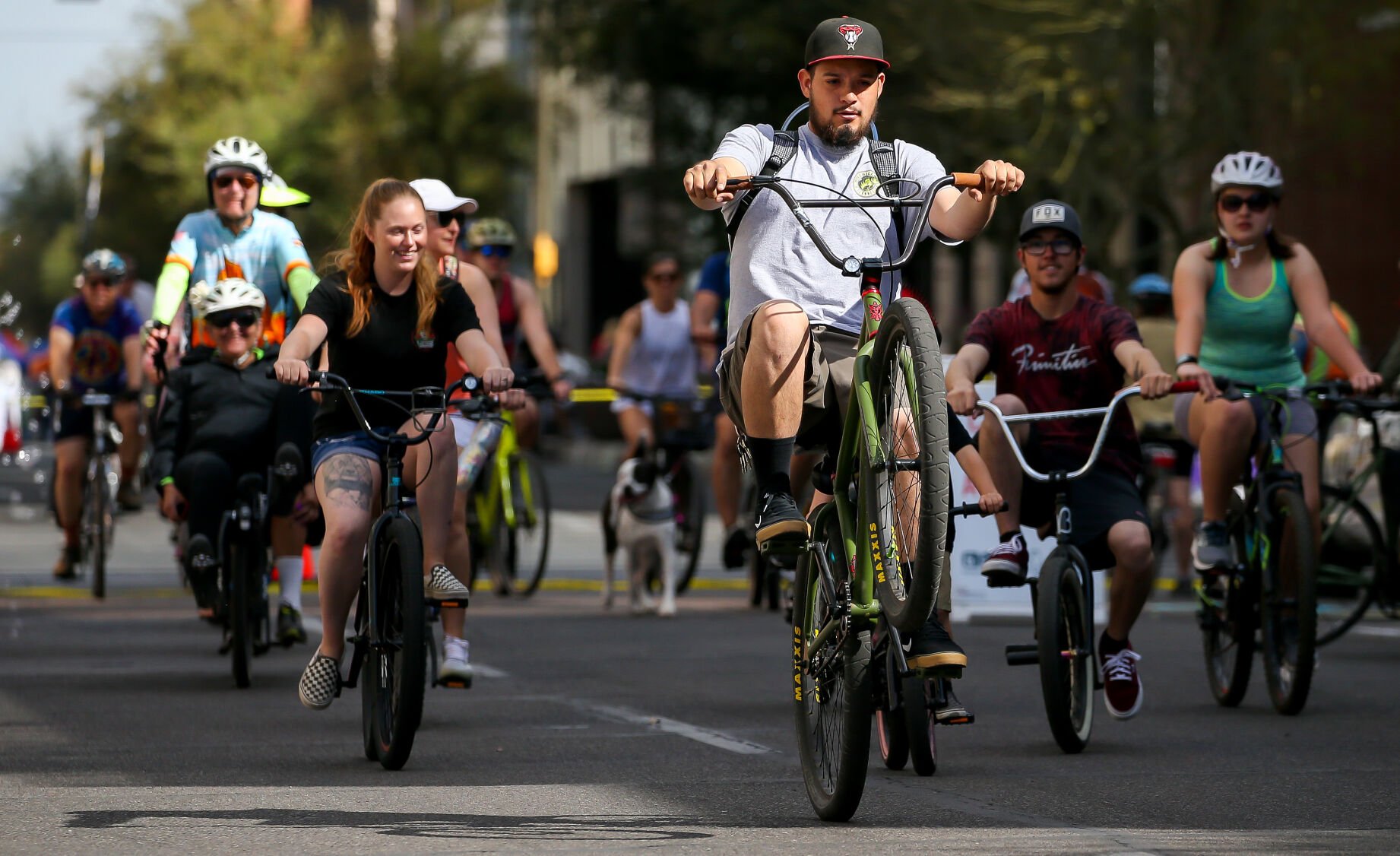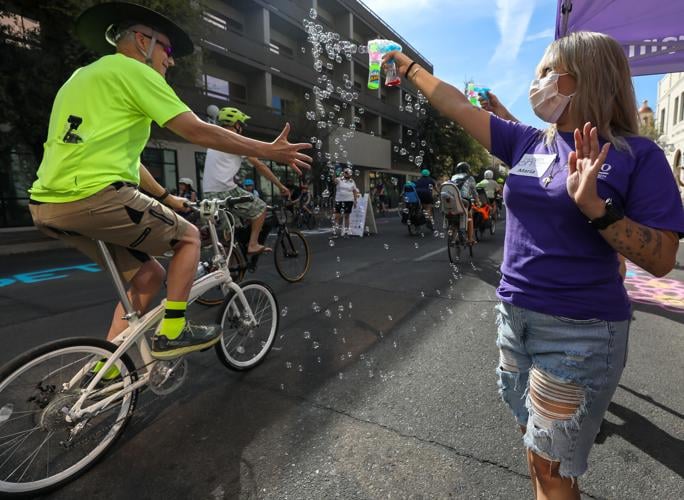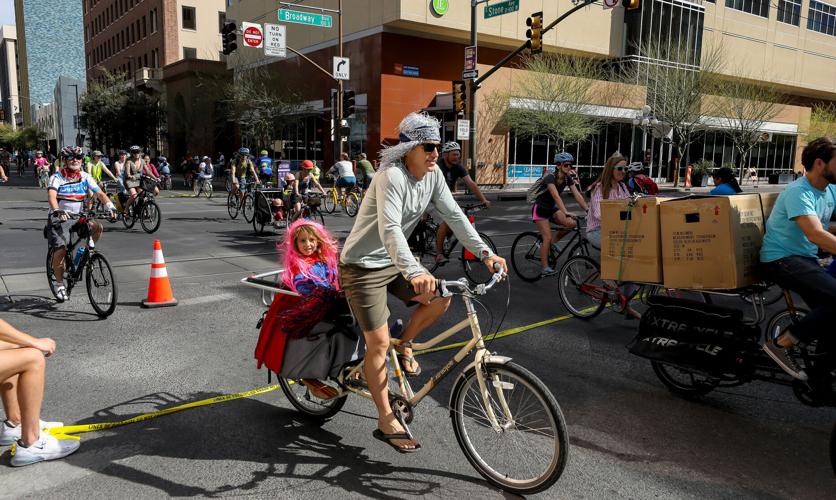Tucson’s biggest block party of the year, Cyclovia, is returning this fall after going on hiatus, with mini block parties to follow in a new initiative.
Twice a year, nonprofit organization Living Streets Alliance puts on Cyclovia, shutting down 2.25 miles of Tucson roads to cars and opening them up to bicyclists, skaters, pedestrians, food trucks and community hubs. The event serves as a way for about 50,000 Tucsonans to come together in an environmentally-friendly way to celebrate community, be active and discover new parts of town, says Living Streets Alliance executive director Emily Yetman.
“People bike, walk, skate, roller skate,” Yetman said. “And then we have activity hubs set up at intervals along the route so that you can walk or ride for a bit and then stop, check out a food truck, catch some live music and interact with some other vendors and community partners that are out on the route.”
This year, the Oct. 27 route will run from downtown to South Tucson, which has been used seven times since 2011. According to a release, from 9 a.m. to 3 p.m., the route will run through some of Tucson’s oldest neighborhoods and connect Armory Park, Santa Rosa Park, three schools, the Children’s Museum Tucson and the Arizona Theatre Company. Expect to find more than two dozen food trucks in addition to activities like bike repairs, art and vendors. See the full route here.

Maria Moreno, right, LPN for El Rio Health, blows bubbles from a bubble gun as cyclists ride down North Stone Avenue during Living Streets Alliance's annual Cyclovia in 2022.
The spring event was cancelled earlier this year so Living Streets Alliance could finish a large strategic planning process, which has been wrapped up, Yetman says.
“We started doing Cyclovia Tucson here in 2010, and it’s been hugely successful, but it continues to get more and more expensive to do the event,” Yetman said. “And at the same time, we hear from people all the time say, ‘This is amazing,’ ‘I want to do this in my neighborhood,’ ‘When can you come do it here?’”
That’s where the new Cyclovita program comes in.
The new program “looks to bring support and resources to neighborhoods hoping to organize their own, smaller open streets event,” says a news release. “While Cyclovia Tucson events are open to the broader public, these smaller events will focus on engaging people in the immediate area.”

Cyclists cruise along North Fourth Avenue near East University Boulevard, during 2019 Cyclovia, where vehicular traffic on certain streets in Tucson are blocked allowing people to walk, ride bicycles, skateboards freely.
An AARP grant of around $19,000 will fund a pilot event in the Amphi neighborhood in early December. Yetman says the organization has been working with the neighborhood to organize the event, and hopes it shows ways to improve for future events.
“The idea is that as we’re going through the process with them, we’re also reflecting and learning together,” Yetman said. “And then afterwards, we’ll also reflect, fine tune the model and hopefully have it ready for broad public consumption by the beginning of 2025.”
Yetman says starting next year, she hopes the organization can help around six neighborhoods annually. While this is something neighborhoods could do on their own with the proper permits, Living Streets Alliance plans to create a toolkit and provide mentorship to ensure everything is done legally.
“If you and your neighbors are like, ‘Hey, we want to do something like this. How do we do it?’ We’ve got kind of a blueprint to share with you,” Yetman said. “We can provide support, mentorship around how to navigate the catering and the permitting process, how to connect with neighbors and finding music. Things like that.”

Adam Springer rides along South Stone Avenue with his daughter Clementine Springer, 5, during Living Streets Alliance's annual Cyclovia on March 27, 2022. Live music, food trucks, educational experiences and more are part of the event.
Yetman says Cyclovitas will need to be kept under a mile, and that the smaller the area, the easier and less expensive the event will be.
“There are some real costs associated with it, so certain neighborhoods will be able to cover those costs themselves, others might need support,” Yetman said. “And so that’s where we want to make sure this is affordable and that we can help find the resources for the neighborhoods that maybe don’t have the funding to hire one barricade company, or rent tents or things.”
For those interested in holding a neighborhood Cyclovita, reach out to info@livingstreetalliance.org for more information early next year. Yetman says she envisions a toolkit will be ready by early 2025, and that it will be similar to a workbook, with both a manual and worksheets to fill out to help guide people through the process.
“So a lot of tutorials and how to’s, but also some resources in there,” Yetman said. “A whole range of things to try and make sure everyone feels equipped.”







